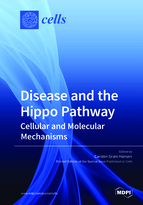Disease and the Hippo Pathway: Cellular and Molecular Mechanisms
A special issue of Cells (ISSN 2073-4409). This special issue belongs to the section "Cell Signaling".
Deadline for manuscript submissions: closed (31 March 2019) | Viewed by 109479
Special Issue Editor
Special Issue Information
Dear Colleagues,
The Hippo pathway is a highly dynamic cellular signaling nexus, integrating mechanotransduction, cell polarity, inflammation, and numerous types of paracrine signaling. The Hippo pathway plays central roles in multiple cell types and regulates regeneration, metabolism and development. If not tightly regulated, dysregulated Hippo pathway signaling drives the onset and progression of a range of diseases, including fibrosis and cancer. The molecular understanding of the Hippo pathway is rapidly evolving, emphasized by the relative recent seminal discovery of the LATS1/2 mediated, but Hippo independent, kinase regulation of YAP/TAZ via the MAP4K family. The aim of this Special Issue is to provide an overview of how a dysregulated Hippo pathway is a common driver of specific diseases, with a particular focus on the underlying molecular and cellular mechanisms that causes the Hippo pathway to go awry, and how this drives disease. We particularly welcome contributions, in the form of either original research articles or concise reviews, with mechanistic and functional insights into either specific diseases or common pathological phenomena caused by Hippo pathway dysregulation.
We hope that the articles will analyse disease-specific, as well as common themes, which will provide valuable insights into the fundamental molecular mechanisms in the dysfunctioning Hippo pathway, and thereby offer practical insights into potential future therapeutic intervention strategies.
Dr. Carsten Gram Hansen
Guest Editor
Manuscript Submission Information
Manuscripts should be submitted online at www.mdpi.com by registering and logging in to this website. Once you are registered, click here to go to the submission form. Manuscripts can be submitted until the deadline. All submissions that pass pre-check are peer-reviewed. Accepted papers will be published continuously in the journal (as soon as accepted) and will be listed together on the special issue website. Research articles, review articles as well as short communications are invited. For planned papers, a title and short abstract (about 100 words) can be sent to the Editorial Office for announcement on this website.
Submitted manuscripts should not have been published previously, nor be under consideration for publication elsewhere (except conference proceedings papers). All manuscripts are thoroughly refereed through a single-blind peer-review process. A guide for authors and other relevant information for submission of manuscripts is available on the Instructions for Authors page. Cells is an international peer-reviewed open access semimonthly journal published by MDPI.
Please visit the Instructions for Authors page before submitting a manuscript. The Article Processing Charge (APC) for publication in this open access journal is 2700 CHF (Swiss Francs). Submitted papers should be well formatted and use good English. Authors may use MDPI's English editing service prior to publication or during author revisions.
Keywords
- Hippo pathway
- YAP/TAZ
- disease mechanism
- mechanotransduction
- GPCR
- inflammation
- regeneration







